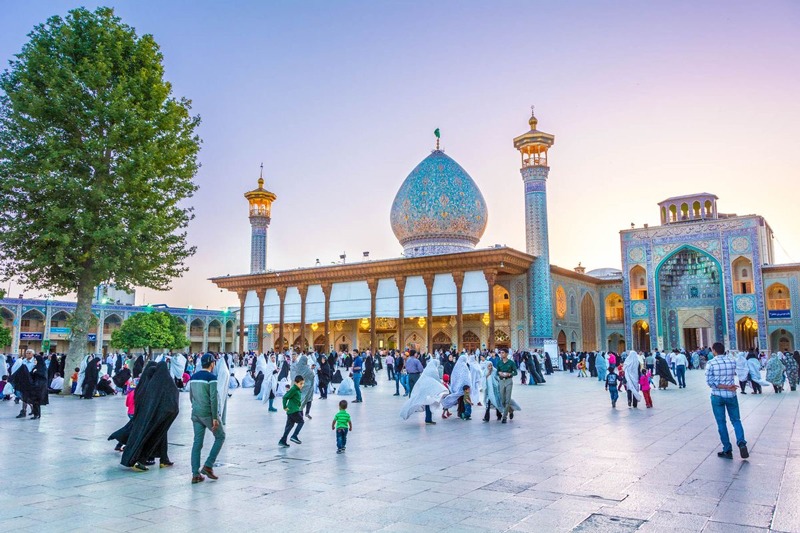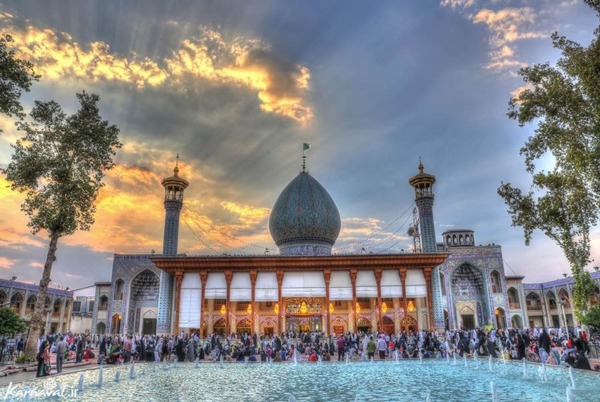
Shah Cheragh in Shiraz
A Journey to Shah Cheragh Shrine in Shiraz
In the heart of the vibrant city of Shiraz lies the revered Shah Cheragh Shrine, a cherished destination that has long been a beacon for both religious pilgrims and curious tourists. Beyond its role as a sacred place for Islamic prayers, Shah Cheragh unfolds a captivating story that spans centuries, offering a mesmerizing experience day and night.
Glowing Jewel in the Night

As the sun sets, Shah Cheragh transforms into a luminous gemstone, radiating a captivating glow that enchants observers. The distinctive architecture and adorned walls come to life, creating an ethereal atmosphere that has made it a popular tourist attraction for many years.
Let’s delve into the historical era of Shiraz and uncover the rich narrative of Shah Cheragh. This memorial and mosque bear witness to the stories of Ahmad and Muhammad, brothers of Ali ar-Ridha and sons of Musa al-Kadhim. Seeking refuge in Shiraz during the Abbasid persecution of Shia Muslims, their tombs became pivotal pilgrimage sites.
The term “Shah-e-Cheragh,” translating to “King of the Light,” originates from Ayatullah Dastgha’ib’s fascinating discovery. Attracted by a distant light, the excavation of a grave emitting light revealed a body in armor with a ring inscribed “The Pride belongs to God, Ahmad son of Musa.” This confirmed it as the burial site of Musa al-Kadhim’s sons.
Tombs and Restoration
In the 9th century, Sultan Mir Ahmad, a brother of Imam Reza, found his resting place near Shiraz. The initial tomb, constructed in the 12th century, evolved over two centuries. Tashi Khatoon, Shah Eshaq Injoo’s mother, commissioned the impressive shrine we see today, complete with a large dome and a theological school. Despite facing destruction from earthquakes and other causes, Shah Cheragh has been the subject of noteworthy restoration efforts, especially during the Qajar dynasty’s rule.
A Symphony of Tiles and Columns

Shah Cheragh Shrine, the primary religious site in Shiraz, showcases a stunning architectural ensemble. Lavishly tiled entrance portals on the northern and southern sides welcome visitors into a spacious courtyard adorned with a turquoise blue star-shaped fountain pool and surrounded by tall trees.
Sultan Ahmad’s tomb, situated in the eastern wing, faces a 10-columned porch, where original wooden columns have been replaced with golden-hued steel. The shrine’s interior boasts intricate mirror-work, covering walls and ceilings with millions of tiny reflective pieces. The floor, adorned with light green marble, leads to the tomb hall with 12 chambers on both sides in two stories.
A Symphony of Decorative Techniques, Kashi Kari and Āina-kāri

The exterior of two-story rooms surrounding the central open space showcases Kashi Kari, an intricate tilework popular in Persian architecture. The congregation halls for Muslims inside Shah Cheragh are adorned with Āina-kāri, a decorative technique using finely cut mirrors arranged in geometric patterns.
The bright illumination from countless mirrors in the mosque halls is breathtaking, earning Shah Cheragh the nickname “Shah Cheragh Mirror Mosque.” The ceilings and roofs of these halls, also known as Shabestan, are embellished with silver, gold, tiles, and mirrors in various geometrical shapes. Muqarnas, a highly intricate embellishment resembling a massive beehive, adds to the opulence.
Amenities: Museum, Library, and Terrace
Within Shah Cheragh, a journey of exploration unfolds through various facilities. The museum, spanning 1,700 square meters, dedicates itself to ancient history and artifacts discovered during renovations. The expansive library, covering 2,500 square meters, houses thousands of books with diverse content, including a collection of one hundred thousand books donated by authors.
To the west of the shrine lies the large terrace dating back to the Qajar dynasty. Stretching 3,830 meters in length, and adorned with ten pillars standing at 10.5 meters tall, the terrace features twelve double-story rooms known as Hijrah—two corridors from the shrine’s main entrance lead to both the terrace and the Shah Cheragh Haram.
Location and Accessibility
To reach Shah Cheragh, start your journey from Ahmadi Square, 9 Dey Road, or the 9 Dey Bus Station. Navigate towards the famous Shah Cheragh Shrine in Shiraz, situated next to the historic house of Manteghi Nejad. The path is as inviting as the destination itself.
Visitor Experience and Recommendation
If you appreciate Islamic architecture and ancient Persian archaeological sites, Shah Cheragh Shrine in Shiraz is a must-visit. The radiant halls and ceilings adorned with remarkable calligraphy in the shrine are truly captivating. The exceptional mosque and the expansive courtyard teeming with birds and trees are equally impressive.
Closing Statement
In the cultured city of Shiraz, the Shah Cheragh Shrine beckons with open arms, inviting all who appreciate Islamic architecture and ancient Persian history. As you embark on this journey, you’ll immerse yourself in a sacred ambiance, surrounded by the rich tapestry of history and architectural marvels. Shah Cheragh is more than a destination; it’s an unforgettable odyssey through time and culture, awaiting the curious traveler with open gates and inspiring tales
Planning a trip to Iran and in need of a travel agency? Explore our Iran tours and Religious Tours to Iran, and feel free to reach out to us. You might discover more exciting things to do in Shiraz.
we would love to hear your comments on tours of Iran

